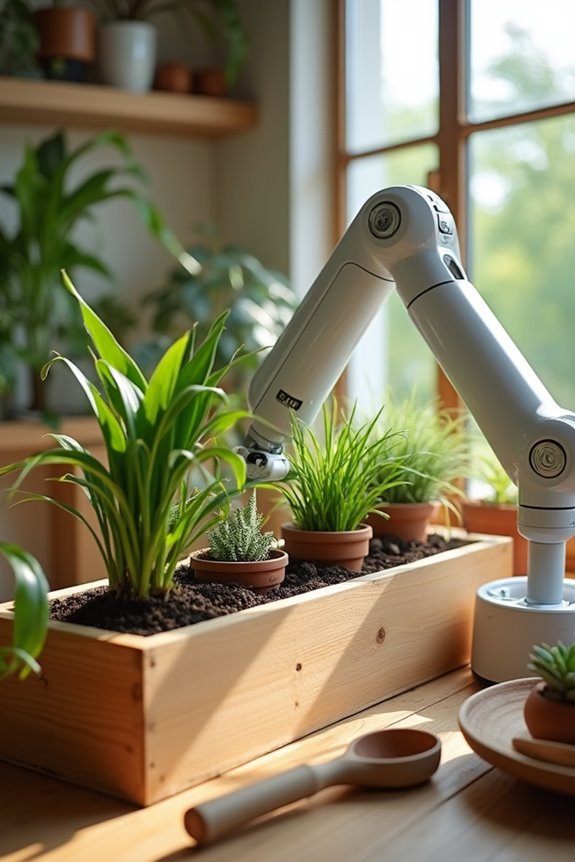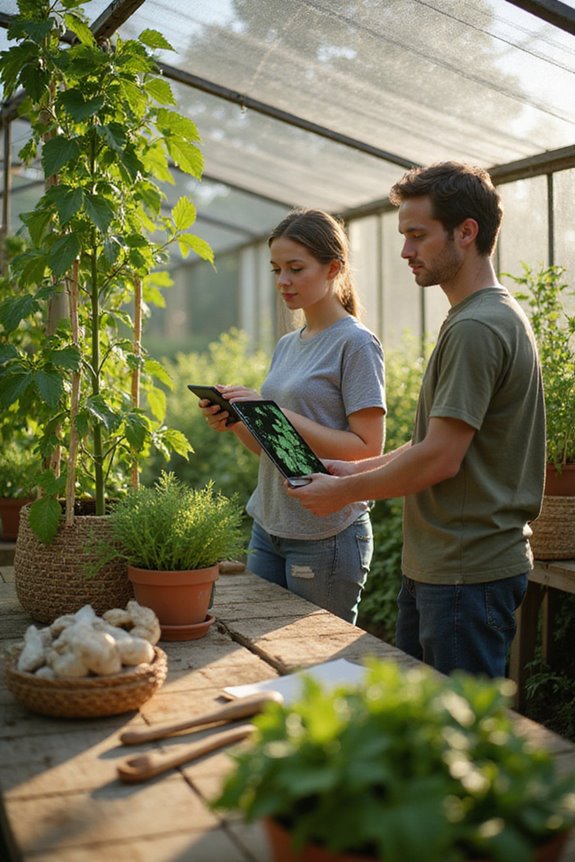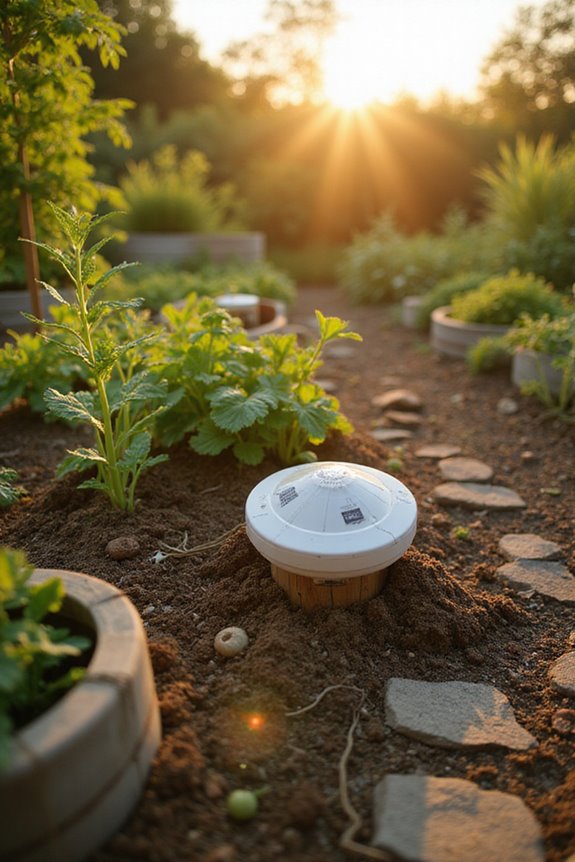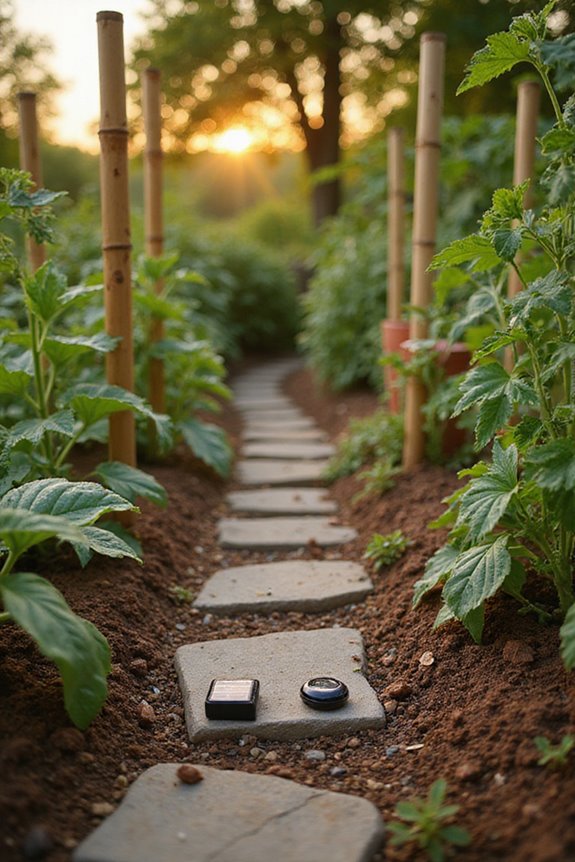Robotic plant care technologies use automation to enhance farming practices. We have automated irrigation and fertilization robots, like RAINOS, that water plants efficiently for long periods. There are also robots for planting seeds accurately and gathering plant health data. These technologies aim to improve crop yields and sustainability while reducing labor costs. If you’re curious about the benefits and future trends of robotics in agriculture, there’s much more to discover.
Key Takeaways
- Robotic plant care technologies include automated irrigation, fertilization, planting, and seeding robots that enhance efficiency in agricultural practices.
- High-throughput phenotyping systems utilize mobile platforms for detailed data collection on plant traits, improving crop yield assessments.
- These technologies provide customization and scalability, allowing farmers to adapt solutions based on specific agricultural needs.
- Robotic systems promote sustainability by optimizing resource management, reducing waste, and minimizing chemical usage in farming.
- Integration with existing agricultural equipment and data analytics enhances decision-making and improves overall farming outcomes.
Automated Irrigation and Fertilization Robots
Automated irrigation and fertilization robots are transforming how we care for plants, making the process more efficient and effective. These robots, like RAINOS, can autonomously water plants without human help for up to 14 hours. They utilize advanced navigation technologies to guarantee precision in watering.
- Precision Irrigation
- Robots adjust water supply based on specific plant needs.
- They reduce water waste by delivering exact amounts at the right times.
- Night-time watering minimizes evaporation and maximizes absorption.
- Electric-powered robots are eco-friendly, producing no local emissions.
Robotic Platforms for Environmental and Plant Data Collection
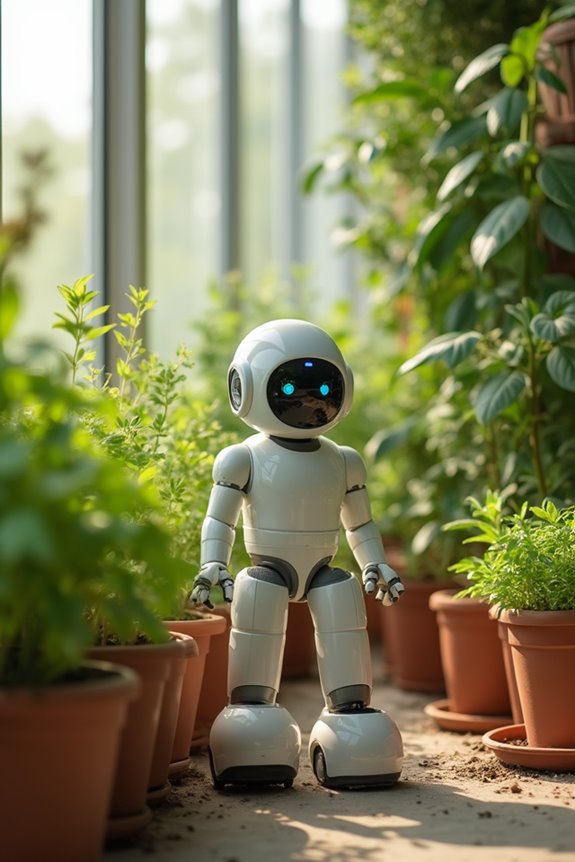
Robotic platforms for environmental and plant data collection are revolutionizing agriculture by providing precise insights into plant health and soil conditions. These systems integrate various sensors, including high-resolution cameras and environmental monitors, to gather essential data. For instance, depth cameras create 3D maps, while infrared sensors check for plant stress.
- Sensor Calibration: Ensuring sensors are accurately calibrated is vital for reliable data collection.
- Data Visualization: The collected data is transmitted wirelessly to remote servers.
- Local Storage: Robots store data locally, ensuring nothing is missed during operations.
Through these technologies, we gain valuable insights that help us make informed decisions about our plants. Together, we can enhance our agricultural practices and optimize plant care.
Planting and Seeding Robots
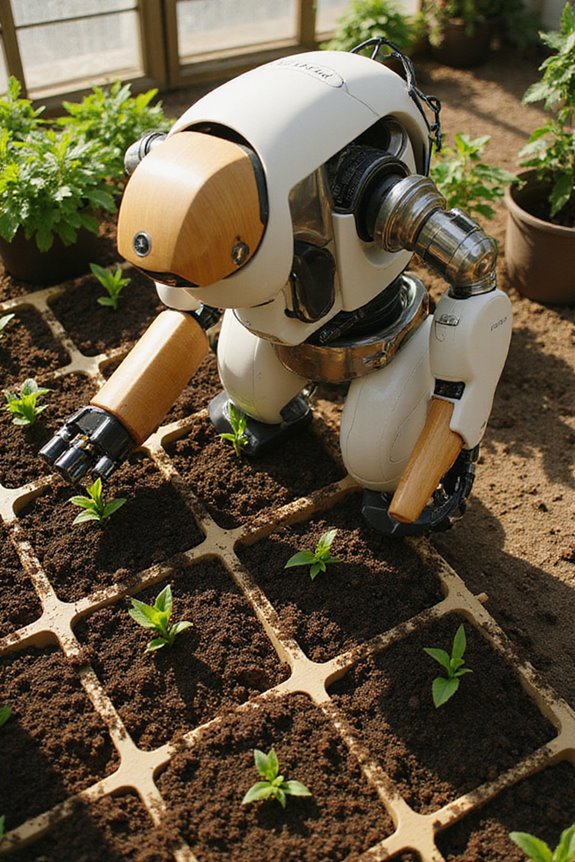
Planting and seeding robots are becoming increasingly essential in modern agriculture, building on the insights gained from data collected by environmental monitoring systems. These robots enhance seed placement accuracy and manage crop density effectively.
- Techniques Used
- Precision Seeding: Ideal for crops like nursery plants, ensuring ideal spacing for better growth.
- Seed Casting: Suitable for microgreens, providing dense seed distribution.
- Automation reduces labor inefficiencies, allowing for continuous operation without fatigue.
- Companies like Rooted Robotics are developing affordable seed casters, essential for vertical farms.
- The market is projected to grow considerably, driven by labor shortages and technological advancements in AI and sensors.
Incorporating these technologies can lead to remarkable improvements in crop yields.
High-Throughput Phenotyping Robotic Systems
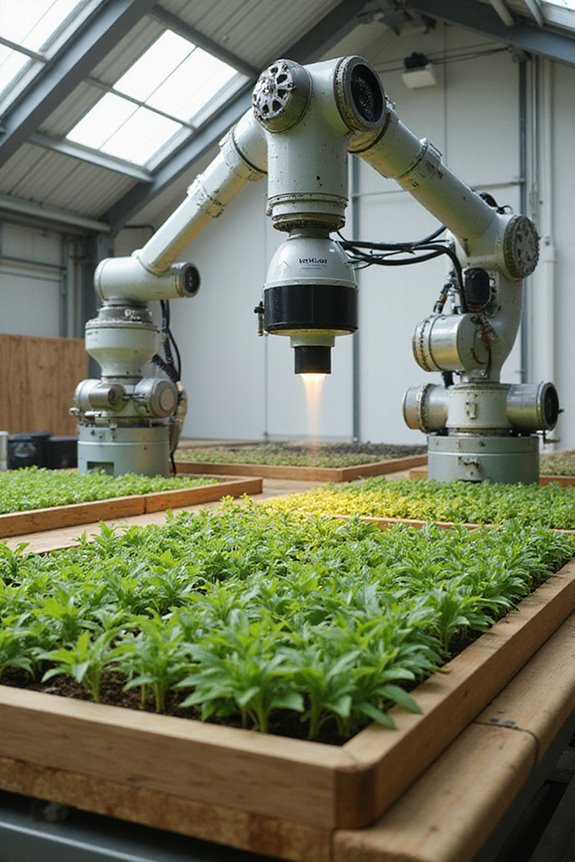
High-throughput phenotyping robotic systems are transforming the way we assess plant traits and improve crop yields. These innovative technologies utilize mobile platforms equipped with sensors to gather detailed data on plant morphology and physiology. This enhances phenotyping accuracy, allowing us to measure traits that were previously difficult to obtain.
- Key Applications:
- Crop Yield Improvement: Breeders can link genotypes to phenotypes effectively.
- Stress Monitoring: Robots help assess biotic and abiotic stresses during growth.
- Crop Diversity: Diverse data aids in developing resilient crops.
- Real-Time Analysis: Instant feedback supports better decision-making.
Robotics in Vertical Farming
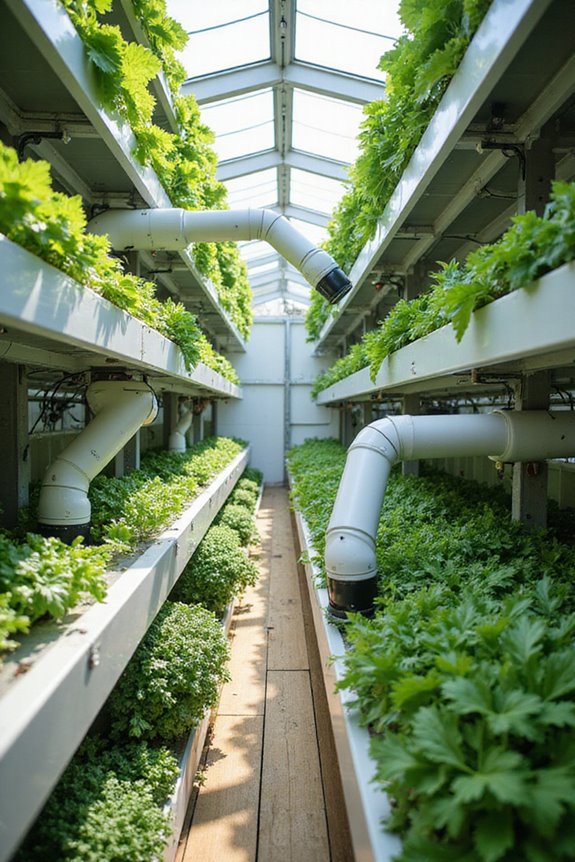
In modern agriculture, the use of automation is reshaping how we cultivate crops, especially in vertical farming. Robotics applications in this field enhance planting and harvesting efficiency. For instance, robots adapt to different plant bed sizes and can harvest crops with speed and precision.
Moreover, these automated systems continuously monitor crop health, delivering nutrients and water accurately while minimizing waste. Companies like Spread showcase vertical farm automation, enabling sustainable production through robotic systems that maintain high-quality yields.
The versatility of multi-axis robots allows for careful handling of delicate plants without damage. By integrating AI, these robots can optimize growth conditions, enhancing overall farm productivity. Together, we’re witnessing a transformative shift towards smarter and more efficient farming practices.
Advanced Sensors and Autonomous Systems Integration
As automation continues to evolve in agriculture, advanced sensors and autonomous systems play a pivotal role in enhancing plant care. These technologies utilize non-invasive sensors for environmental monitoring, collecting data on soil moisture, temperature, and light intensity. Through sensor fusion, they combine various data points to help us make informed decisions about plant care.
- Robotic platforms like the SMART Plant F-Series navigate autonomously using GPS and laser sensors.
- They continuously monitor both aboveground and belowground plant health.
- AI-driven systems interpret complex data, ensuring timely actions like irrigation adjustments.
This integration not only optimizes plant conditions but also promotes sustainable practices, allowing us to care for our plants effectively while conserving resources.
Benefits of Robotic Plant Care Technologies
Robotic plant care technologies offer numerous benefits that can transform our approach to agriculture. First, these tools enhance robotic efficiency by automating tasks like planting and harvesting, allowing us to complete work faster and with less labor. This means we can maintain productivity even during labor shortages.
Second, they support sustainable farming practices. Robots apply fertilizers and pesticides precisely, reducing waste and minimizing environmental impact. They optimize irrigation, conserving water in drought-prone areas.
Lastly, robotic systems improve crop quality and food safety. By monitoring crops continuously, we can guarantee better handling and reduce spoilage. With these advancements, we’re not just improving our farms; we’re also contributing to a healthier planet for everyone.
Challenges in Implementing Robotic Solutions
Implementing robotic solutions in agriculture brings several challenges that we must acknowledge.
- Financial Constraints: High upfront costs for robots can be prohibitive, especially for small-scale farmers. Funding options are limited, and shared ownership models are underutilized.
- Skill Disparities: Many farmers lack the technical training needed to operate these systems. Training is often only available through universities, leaving rural areas at a disadvantage.
- Infrastructure Gaps: Poor connectivity and power supply in rural areas hinder the effectiveness of robotic systems.
- Regulatory Issues: Unclear regulations create uncertainty for users and developers, discouraging investment.
- Engineering Challenges: Current robotic technologies may struggle with delicate tasks, such as fruit picking, impacting efficiency.
These factors collectively create operational hurdles that we need to address for successful implementation.
Future Trends in Agricultural Robotics
The future of agricultural robotics is set to transform farming practices considerably. We can expect robotic innovations that enhance AI and machine learning, allowing robots to adapt to field conditions in real time. This future automation will enable precise pest detection and yield prediction, making farming more efficient.
Moreover, the integration of IoT with agricultural robots will optimize resource use, like water and fertilizers, fostering sustainability. Connected devices will guarantee real-time monitoring of crops, enhancing decision-making.
As costs decrease, these technologies will become accessible to small farms, broadening their reach. With modular and scalable options, farmers can customize solutions based on their needs. Together, we can look forward to a more productive and sustainable agricultural landscape.
Frequently Asked Questions
How Do Robotic Plant Care Technologies Impact Traditional Farming Jobs?
We see robotic plant care technologies driving job displacement in traditional farming, transforming roles and requiring skill evolution. As we adapt, it’s essential to embrace new opportunities for growth and collaboration in this changing landscape.
What Are the Costs Associated With Implementing Robotic Systems?
When we weigh the costs of implementing robotic systems, the initial investment feels hefty, but we can reap long-term savings. By embracing these technologies, we’re paving the way for a more efficient future together.
Can These Robots Operate in Extreme Weather Conditions?
Absolutely, these robots can operate in extreme weather conditions. Their weather resilience and robotic durability guarantee they handle rain, wind, and heat effectively, making them reliable partners for us in nurturing our plants, regardless of the elements.
How Do Robots Ensure the Safety of Delicate Plants During Handling?
When we think about how robots guarantee the safety of delicate plants, their robotic precision and gentle handling stand out. We can trust that these technologies adapt and protect our green companions with utmost care.
What Skills Are Needed to Operate and Maintain These Robotic Systems?
To operate and maintain robotic systems, we need skills in robotics programming and system maintenance. Embracing teamwork and sharing knowledge helps us master troubleshooting, ensuring our robots perform effectively while safeguarding our delicate plants.

